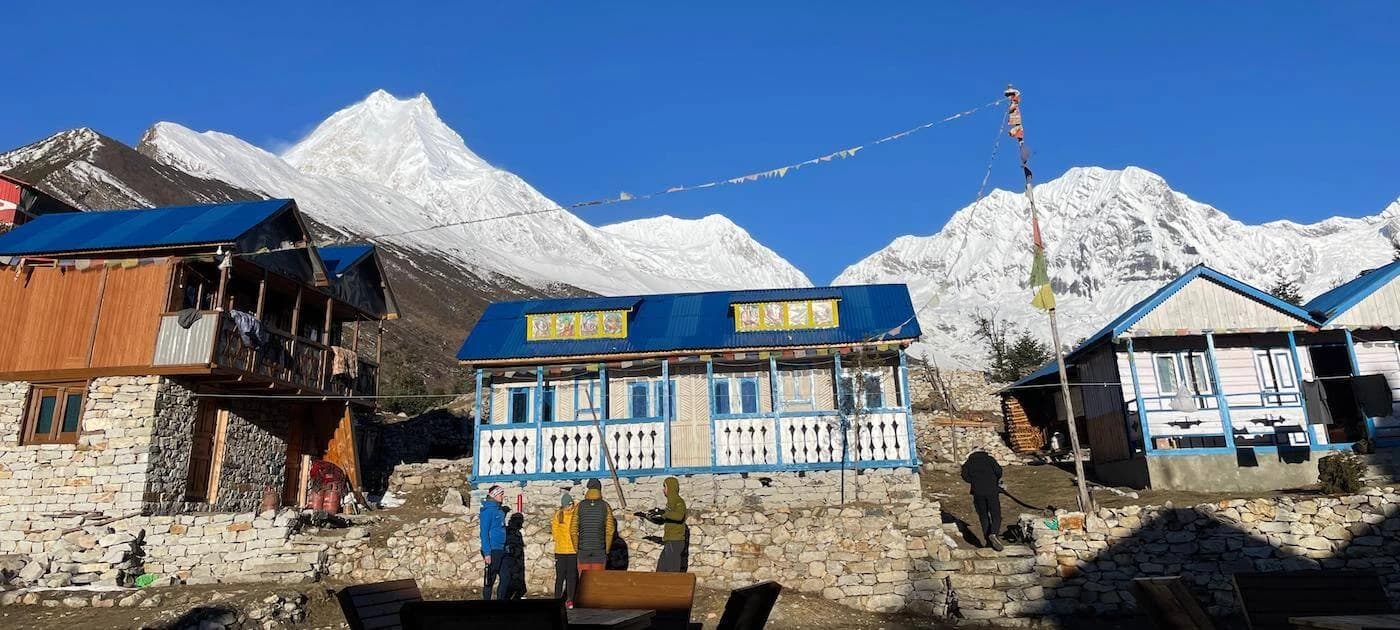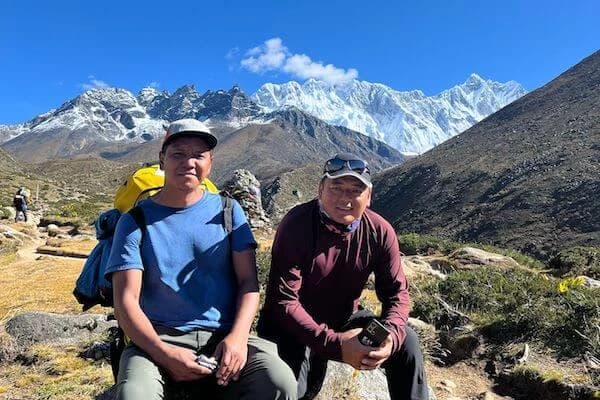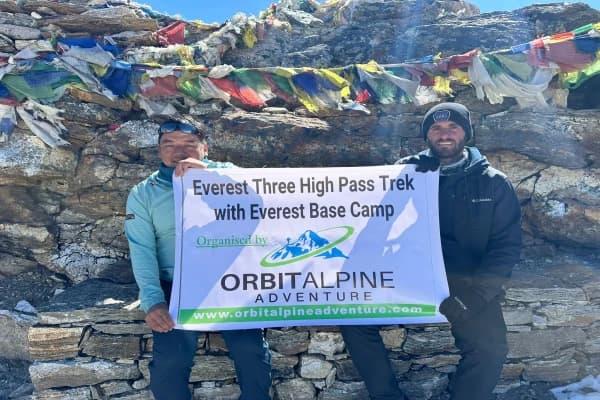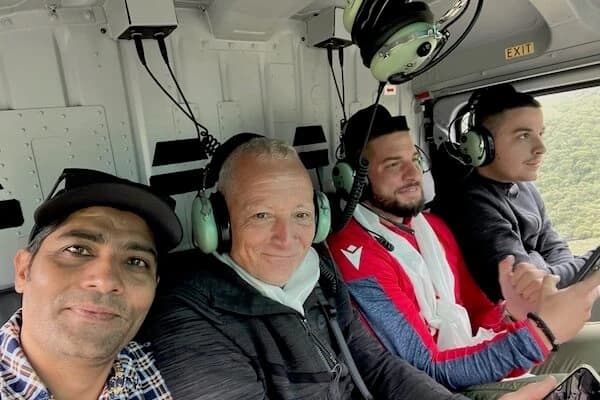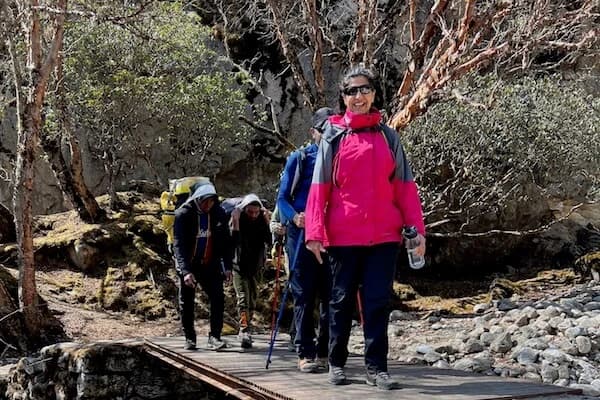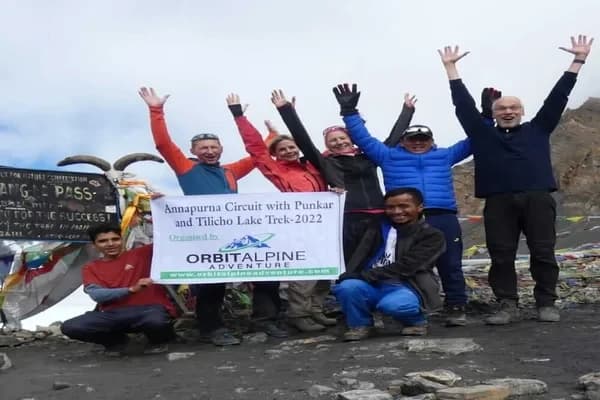As far as the Manaslu Circuit Trek goes, it is definitely an adventure through the heart of Nepal's Himalayas, and it does represent an exclusive fusion of natural beauty, cultural richness, and adventure. Situated at 8,163 meters, Mount Manaslu is the eighth-highest peak in the world, spinning around various sceneries of luxurious subtropical forests and rocky mountainous territory. Since its opening up for foreign trekkers in 1991, the Manaslu region is still largely restricted, bringing out the virgin beauty.
Explore Manaslu Circuit Trek
The Budhi Gandaki River flows across the district, passing through the traditional villages inhabited by the various ethnic groups - Gurungs, Tamangs, and communities influenced by Tibet. Ancient monasteries, prayer flags, and mani walls underline the region's significant Buddhist identity and the spiritual feel of the trek. The trek of interest is the challenging Larkya La Pass at an altitude of 5,106 meters where fine views of the surrounding peaks and glaciers await the trekkers.
Manaslu Circuit is less trafficked compared to the Everest or Annapurna region, and therefore it is more peaceful. The trek is suitable for adventure tourists, and it preferably takes 14–18 days. The trek finest suits trekkers who sustain high levels of fitness and can properly adjust during the trek. The Manaslu Circuit Trek offers incredible mountain scenes, cultural experiences, and an atmosphere of wilderness that one would love to have in their Himalayan venture.
Highlights of the Trek
The Manaslu Circuit Trek is an outstanding journey that includes natural attraction, cultural come across, and journey, making every trekker love it. Here are the major places of interest of what makes this trek different from others:
Scenic beauty of mountains
The trek will have some breathtaking views of the Himalayan high peaks, including the world's eighth highest, Mount Manaslu at 8,163 meters. Other major peaks seen on the way are Himlung Himal, Ganesh Himal, and Annapurna II. The trail will take you through various landscapes crossed by lush subtropical forests, alpine meadows, and high-altitude glaciers.
Climbing Larkya La Pass (5,106 meters)
The Larkya La Pass is the most challenging height of the trek, but at the same time very exhilarating. Breathtaking vistas of snow-covered peaks and glacial valleys await the trekkers along with rugged terrain; it's a true test of endurance and really a highlight of the journey.
Rich Cultural Experience
The trail traverses through villages of Gurung, Tamang, and Tibet, in themselves carrying loads of cultural experiences. Samagaun and Samdo villages resemble Tibetan Buddhist culture, with ancient monasteries, mani walls, chortens, and prayer flags. Interactions here are excellent exposures to the lives of the local people.
Remote and Untouched Trail
Unlike crowded Annapurna or Everest regions, the Manaslu Circuit trek is quite peaceful and not too commercialised. This aspect of remoteness gives it a further attraction so that trekkers can relate with nature to their deepest core and savour an experience of true Himalayan adventure.
Biodiversity in the Manaslu Conservation Area
The trek crosses through the Manaslu Conservation Area-the protected and one of the richest areas for its variety of flora and fauna. Rare species such as snow leopard, Himalayan tahr, blue sheep, and red panda can be seen, as can colorful rhododendron forests.
Day Trips and Add-ons
While additional optional treks to Manaslu Base Camp or culturally rich Tsum Valley add a layer of depth for the adventurous and culturally interested trekker, it is otherwise one trip with rugged landscapes, cultural richness, and the thrill of high-altitude trekking to promise a once-in-a-lifetime Himalayan experience.
Route and Itinerary
The Manaslu Circuit Trek usually takes 14 to 18 days, depending on the acclimatisation and the optional detour. Extremely rich in landscapes and culture, the trek primarily follows the course of the Budhi Gandaki River from subtropical lowlands up to the alpine highlands and then crosses the Larkya La Pass at 5,106 meters.
Regular 17-Day Itinerary
Day 1: Kathmandu to Soti Khola (700 meters) Drive 7–8 hours through rural scenery to the village of Soti Khola, which is the starting point of the trek.
Day 2: Trek Soti Khola to Machha Khola (869 meters) 6-7 hours of trekking through the forest, rice terraces and rocky paths along the Budhi Gandaki River
Day 3: Trek Machha Khola to Jagat (1,340 meters) The path continues steadily through forests and villages, with waterfalls and hot springs, passing onto the permit control point Jagat.
Day 4: Jagat to Deng (1,860 m) The trail enters the Manaslu Conservation Area with fantastic river gorges and suspension bridges and influences from Tibetan settlements.
Day 5: Deng to Namrung (2,630 m) This time the climb is steeper and steeper, with a fair bit of forested terrain, although one does occasionally get glimpses of snow-capped peaks.
Day 6: Namrung to Samagaun (3,530 m) Pass through villages like Lho and Shyala, and enjoy spectacular views of Mount Manaslu. Samagaun is a cultural and acclimatisation center.
Day 7: Acclimatization Day at Samagaun Hike to either the Manaslu Base Camp (4,800 m) or the picturesque Pungyen Gompa, both giving spectacular views of Manaslu and other peaks.
Day 8: Samagaun to Samdo (3,860 m) A short trek to Samdo, a really quite scenic village in Tibet near the border between Nepal and Tibet.
Day 9: Samdo to Dharmasala, or Larkya Phedi (4,460 m) Steading climb up to base for crossing the Larkya La Pass
Day 10: Cross Larkya La Pass to Bhimthang, 3,720 m Trek's most challenging day is literally climbing up steeply to the Larkya La Pass with breath-taking panoramic views. Then descend down to Bhimthang.
Day 11: Bhimthang to Tilije (2,300 meters) Walk downhill through rhododendron forests and alpine meadows, accompanied by peaceful streams and verdant valleys.
Days 12-13: Tilije to Dharapani and Besi Sahar Trek down to Dharapani. Mark the end of the trek at Besi Sahar after a brief drive. This itinerary balances the test of physical endurance with acclimatisation and immersion in local culture for an unforgettable Himalayan expedition.
Better follow the guide to Manaslu Circuit Trek to make your travel easy and reduce the obstacle.
Culture and Communities
The Manaslu Circuit Trek gives one a glimpse of the rich exciting culture and traditions of the people living in the shadow of the Himalayas. The region is home to an excess of ethnic groups: the Gurungs, Tamangs, and Tibetan-influenced communities, who give the area an exceptional cultural fabric.
Buddhist Influence
As the trail climbs, Tibetan Buddhist culture becomes strongly in evidence. Villages such as Samagaun and Samdo are punctuated by monasteries, chortens, and prayer wheels reflecting deep-seated spiritual traditions. Ribung Gompa in Samagaun is an important landmark, giving some insight into local religious practices.
Way of Life and Local Traditions
These people live very simple and sustainable lives, mainly based on agriculture, livestock, and trade. Local practices, such as yak herding and woolen garment weaving in higher altitudes, are still followed by most. Majority of the households continue the age-old customs and rituals followed by them due to their religious beliefs.
Warm Hospitality
Despite the weather conditions and isolation, villagers are extremely warm and welcoming. The trek through teahouses is a real experience of cultural life whereby trekkers marry with the village to share meals and stories. The Manaslu region does not only flavour the trek but also takes a deep appreciation for the resilience and traditions of the Himalayan people
Flora and Fauna
Manaslu Circuit Trek passes through the Manaslu Conservation Area, which remains reasonably well-conserved in terms of its high biodiversity. The trek covers a wide range of ecosystems that make it unique in the sense that a variety of flora and fauna is seen along the ascend from subtropical lowlands to alpine highlands.
Flora: The lower elevations are covered with lush subtropical forests, sal, pine, and oak trees. Further up, the trekker comes across dense rhododendron forests, full of colour in the spring season. Beyond the tree line, the vegetation gives way to alpine meadows and hardy alpine shrubs.
Fauna Rarity and Endemic Wildlife Several species such as Snow leopard, red pandas, Himalayan tahr, and blue sheep may often be sighted. In fact, many of the best bird species abound in Nepal, including the Himalayan griffon, blood pheasant, and the Danphe, Nepal's national bird. This eloquent mix of flora and fauna makes the trek even more beautiful to explore for trekkers as it connects them better to the pristine surroundings of the Himalayas.
Challenges of the Trek
The Manaslu Circuit Trek is a long and steep adventure. The primary mountain conditions this trekkers will be exposed to are the following:
1. Altitude Sickness They will encounter a high altitude summit when they ascend to Larkya La Pass at 5,106 m. This puts the risk of AMS to trekkers. Acclimatization may not be enough if he or she experiences headaches, nausea, and fatigue. Proper hydration, gradual ascents, and rest days are absolutely crucial.
2. Physical Demands This trek is a pretty long one, 14–18 days, climbing for hours and down again. The daily treks can be quite long, 5-8 hours, with at several points requiring technical skill, near Larkya La Pass. Good shape and endurance are requirements .
3. Very Remote Terrain It traverses through unkind and remote landscapes with fewer comforts. There are few teahouses and no medical support, especially at the higher altitudes. The essentials, including all trekking gear, have to be carried, and one may need to be prepared for anything in terms of weather.
4. Weather Condition Himalayan weather is capricious. Surprise snow storms or heavy rain can make trails slippery and crossing dangerous, especially at Larkya La Pass.
Packing some Essentials
Packing the right gear is very essential for any successful and comfortable Manaslu Circuit Trek. With such varied altitudes, remote terrain, and unpredictable weather, here is the list of essentials: Packing the right gear is crucial for a successful and comfortable Manaslu Circuit Trek. Given the trek's varying altitudes, remote terrain, and weather unpredictability, here's a list of essentials:
Clothing
- Base Layers: Moisture-wicking thermal tops and bottoms for warmth.
- Insulating Layers: fleece or down jacket for colder altitudes.
- Outer Layers: waterproof and windproof jacket and pants Trekking Pants and Shirts: lightweight and quick-drying options.
- Gloves: Thermal inner gloves, waterproof outer gloves.
- Headwear: Warm hat, sun hat, and buff or scarf.
- Socks: woollen socks for warmth, liner socks.
- Footwear: trekking boots with a good ankle support
Gear
- Backpack: 40–60L capacity with a rain cover.
- Sleeping Bag: Rated for temps as low as -15°C.
- Trekking Poles: For steep ascents and descents. • Headlamp: Extra batteries for early morning and nights.
- Water Bottles and Purifiers: Reusable bottles and purification tablets or filters.
Miscellaneous
- First Aid Kit: For altitude sickness, blisters, and general injuries.
- Snacks: Energy bars, nuts, and chocolates for instant power boosts. • Toiletries: Biodegradable soap, wet wipes, hand sanitizer, and sunscreen.
- Private Effects: Passport, permits, cash is not available in the trail
- Electrical devices: Power bank, camera, and extra memory cards. Proper packing ensures comfort and safety in the trek, hence making the adventure worthwhile
Permits and Requirements
Manaslu Circuit Trek is classified as a restricted area, hence special permits are needed to penetrate into it. The two peremptory permits are:
1. Manaslu Conservation Area Permit (MCAP): An entry requirement that goes for about $30 USD.
2. Annapurna Conservation Area Permit (ACAP): Must obtain for trekking into the Annapurna region beyond Dharapani.
3. Restricted Area Permit: Required for Manaslu region; about $100 per week and only available through a licensed trekking company. One should always have a licensed guide or porter to accompany the trek. Paperwork plus guide ensure that many regulations are adhered to
Best Time to Trek
The best seasons for trekking Manaslu Circuit are spring and autumn. Such seasons experience the most favourable conditions concerning weather and trek conditions.
Spring: March to May This is probably one of the favorite times to trek, thanks to spring weather: mild with moderate daytime temperatures in the range of 10-20°C and nights at high altitude still quite chilly. Perfect for clear skies, all those peaks can be nicely viewed, especially including Mount Manaslu, and the landscapes are further enhanced by colorful rhododendrons in full bloom. Spring acclimatisation is also ideal.
Fall (September to November) Autumn is another significant trekking season. There's stable weather, cool to moderate and clear skies. It's perfect for the best visibility and the great views of the mountains. It is much quieter than the Everest or the Annapurna regions with very few crowds. Early autumn, with a favorable balance between pleasant temperatures and fewer trekkers, is particularly great.
Winter is from December to February. Winter brings the chill and the snow, especially at higher altitudes, such as Larkya La Pass. Although trekable, previous arrangements must be made, along with warmer clothing, plus a degree of safety, considering the adversarial conditions. Monsoon (June to August) The time of monsoon is usually avoided because of the heavy rain, which is slippery and precarious at times, especially when trying out less travelled trails.
Responsible Trekking Practices
Therefore, well-observed sustainable trekking practices are mandatory to ensure respect for doing the Manaslu Circuit Trek, because preserving the environment and supporting local communities are mandatory. Major practices include:
1. Leave No Trace: Packed all trash, including wrappers from food and plastics, to minimise the effects of your actions on the environment.
2. Respect Local Culture: There is knowledge of local customs and dressing modestly. Also, permission is taken to take pictures of people or religious sites.
3. Spend your nights in the locally owned teahouses and hire local guides, buy goods from local markets to feed into the community's economy
4. Use Water Purification Tablets or Filters and Refuse to Bring Disposable Plastic Bottles
5. Low Carbon Footprint: Go for eco-friendly transportation, minimize waste by picking sustainable gear to trek on
Variance Route and/or Side Trips
Alternative routes and detours in the Manaslu Circuit Trek for those trekkers seeking an even more elevated experience:
1. Tsum Valley: Often called a hidden valley. A place that's spiritually far but has Tibetans, rich in culture, and sceneries. There's an extra day or two because it forms a detour while proceeding to Samagaun.
2. Manaslu Base Camp: For some short adrenaline on high altitude, the diversion towards Manaslu Base Camp (4,800 m) offers breathtaking views of the mountain.
3.Rupinala Pass: This is an optional route available for the adventurous trekkers, avoiding Larkya La Pass and offering different exclusive views of Manaslu and its surroundings. These routes offer chances to dive into culture further and explore even farther.
Conclusion
Manaslu Circuit Trek is one such journey that, at one go, is full of spectacular mountain views and experience rich cultural surroundings, diversified landscapes. If you got short of time, then Manaslu Short trek could be the best option for you. Nepal has the remotest and least-trekked routes; this offers a chance to explore untouched nature and immerse yourself in the traditions of local Tibetan-influenced communities. From the forests and terraced fields of the low altitude, the trek challenges the climber to reach the high-altitude crossing of Larkya La Pass at an elevation of 5,106 meters.
The beauty of the region also lies in its biodiversity, hosting rare creatures like snow leopards and red pandas. Spiritual ambiance will also entice trekkers through monasteries, prayer wheels, and Buddhist rituals. The adventure is further enriched with the opportunity to experience warm hospitality from local people and learning about their ancient culture. Such a trek demands preparation and knowledge of what lies ahead: possible risks to altitude sickness, physiologic conditions, and capricious weather.
One of the most unforgettable experiences in Nepal, this should best be undertaken in the spring or autumn season of the year, and this Manaslu Circuit Trek offers adventurous travellers a rare chance to trek through some of the most unexplored and beautiful ranges of the Himalayas. This is a treacherous hike that defies endurance but, in doing so, connects the trekker to the soul of the mountains
